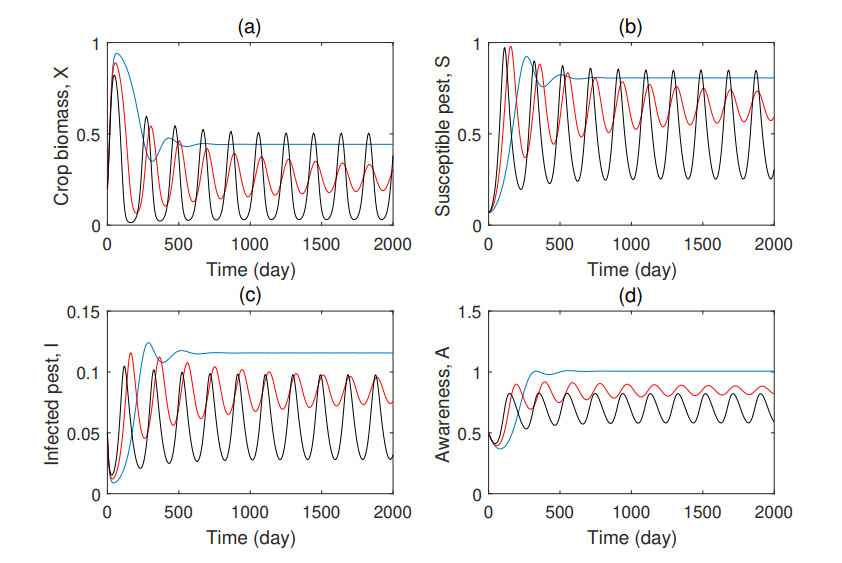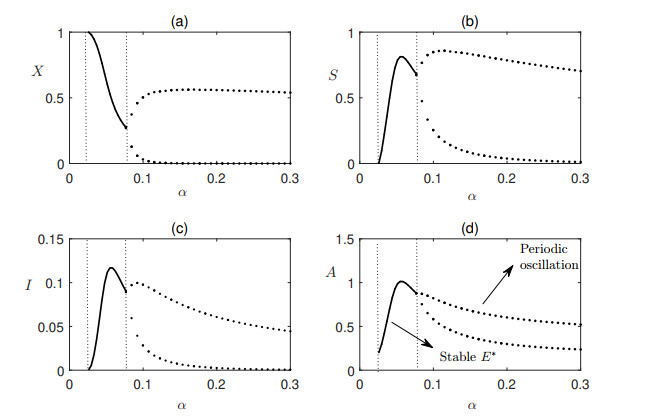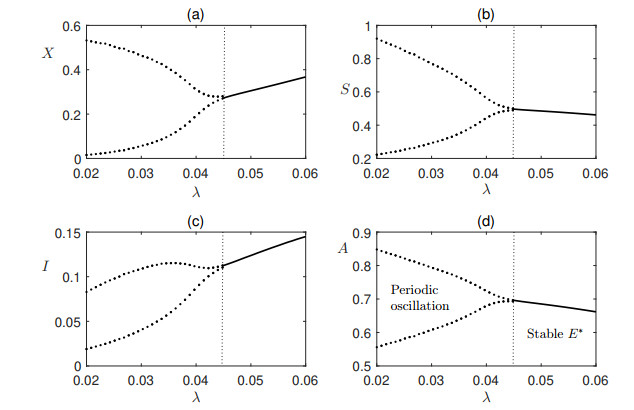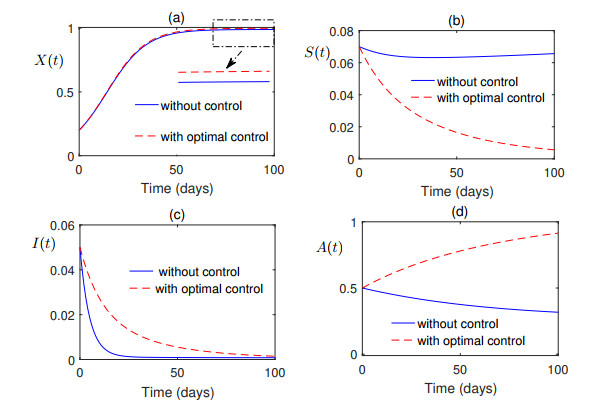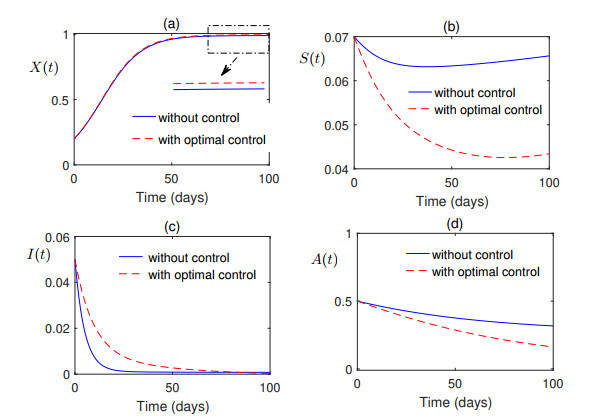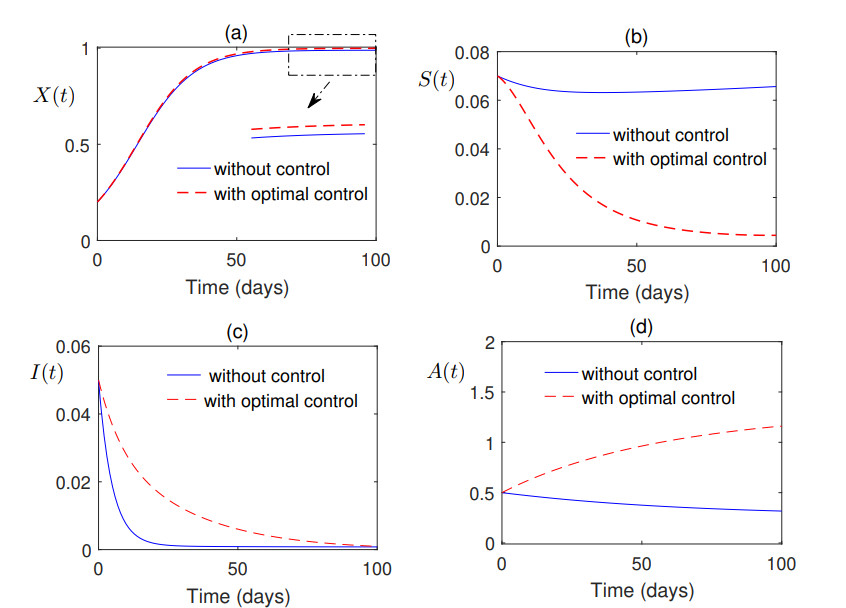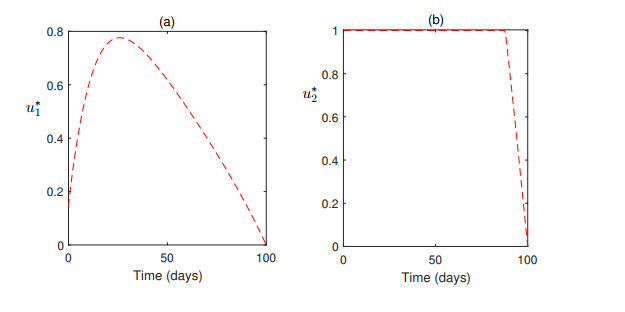1.
Introduction
Pest control is a worldwide problem in agricultural and forest ecosystem management, where mathematical modeling has an important impact [1,2,3]. Broad-spectrum chemical pesticides have been used in abundance in the containment and annihilation of pests of medical, veterinary, agricultural, and environmental importance. Although chemical plant defense plays a significant function in modern agricultural practices, it is at rest viewed as a profit-induced poisoning of the surroundings. The non-degradable chemical residues, which construct to damaging stages, are the core cause of health and environmental hazards and most of the present hostility toward them. The imperative role of microbial pesticides in integrated pest management, is well-known in agriculture, forestry, and public fitness [4,5,6]. As included pest administration, biological pesticides give noticeable pest control reliability in the case of plants [7]. The employ of viruses alongside insect pests, as pest control agents, is seen worldwide, in particular in North America and European countries [8].
Agricultural practitioners should be awake of the threats accessible by pests and diseases and of fitting steps that may be taken to prevent their incidence and to undertake them should they become problematic. Responsiveness campaigns, in meticulous through radio or TV, are required so that people will gain trustworthiness on a biological control approach. Farmers, in their awareness, can stay the crop beneath surveillance and, so, if properly trained, they will send out bio-pesticides or fit in productive to build the pest vulnerable to their bio-agents [9].
Precise and pertinent information about plants and their pests is necessary for people occupied in crop growing. The role of electronic media is crucial for observing the farming society rationalized and by providing pertinent agricultural information [7]. Accessible pesticide information campaigns help farmers to be aware of the grave threats that insect killers have on human health and the environment, and to reduce negative effects [10]. Accepting consciousness programs, planned to teach farmers', fallout in improved comprehensive growth for the cultivars and also for the farmers. Farmers be trained the use and hazards of pesticides mostly by oral announcement. Self aware farmers occupy considerably improved agronomic perform, safeguarding the health and reducing environmental hazards. Therefore, alertness is vital in crop pest administration [11].
Damage of plants by pest plague is a solemn international fret in not only farming fields, but also in afforests ecosystems. This problem, linked with pests, has been realized since the crop growing of harvest started. About 42% of world's food afford is exhausted because of pests. In former days, chemical pesticide was used to control pests, but intense use of chemical pesticides in farming produces a lot of side effects. Pest renaissance and secondary pest outbursts are two of the key problems. Mathematical models have great reimbursements for relating the dynamics of crop pest management. Quite a few models have been formulated and analyzed to explain the dynamics of plant disease diffusion and charging their controls [12]. For instance, authors in [13] consider how allowing surroundings for connections among farmers, researchers, and other factors, can donate to reduce existing problems related with the crop. Al Basir et al. describe the participation of farming communities in Jatropha projects for biodiesel construction and guard of plants from mosaic disease, using a mathematical model to predict the growth of renewable power resources [14].
In [15], Chowdhury et al. derive a model for the control of pests by employing biological pesticides. Furthermore, they also include optimal control theory to reduce the cost in pest administration due to bio-pesticides. For more on optimal control theory to eradicate the number of parasites in agro ecosystems, see the pioneering work [16,17,18]. In [19], Al Basir and Ray investigate the dynamics of vector-borne plant disease dynamics influenced by farming awareness. In [20], Pathak and Maiti develop a mathematical model on pest control with a virus as a control agent. They consider the mutual relations going on an ecosystem where a virus influences a pest population nosh on a plant, the final creature unaltered by the virus. They prepare a time-delayed model and prove a blend of detailed analysis of the model. In concrete, they show the positivity and boundedness of solutions, the dynamical behaviors of the model in the lack and occurrence of time-delay. In [12], Al Basir et al. prospect a mathematical model for recitation of the level of wakefulness in pest control, together with biological pesticides, which are exactly the most ordinary control mechanisms used in integrated pest administration based control outlines. They assume the speed of flattering aware is comparative to the number of vulnerable pests in the meadow. They prepare the model as more realistic, bearing in mind the time delay due to assess of pest in the field. Non-negativity of the solutions is analyzed, by finding the invariant region. Stability analyses of the systems has been studied using qualitative methods. The obtained analytical results are then verified through numerical simulations. In [7], Al Basir develop a new model by employing delayed differential equations to learn the vibrant of crop pests interacting system prejudiced via a responsiveness movement. The author tacit the rate of becoming aware is relative to the number of susceptible pests within the grassland.
Here, a mathematical model is formulated to defend crops through awareness movements, modeled via saturated terms, and an optimal control problem for bio-pesticides is posed and solved. More precisely, a compartmental model is developed with ordinary differential equations to study the force of farming awareness-based optimum interventions for crop pest control (section 2). It is assumed that with the pressure of bio-pesticide, a susceptible pests population becomes infected. Infected pests can harass the plant but the rate is very smaller than susceptible pests. Hence, we suppose that infected pests cannot guzzle the plant biomass. Non-negativity and boundedness of the solutions are proved by computing the feasible region (section 3.1). Stability analysis of the dynamics is carried out (section 3.2). Optimal control techniques are then investigated (section 4). In concrete, optimal control theory is practiced in the dynamics to reduce the price of pest administration. Our analytical results are illustrated by computing numerical simulations (section 5). Lastly, we end up the paper with discussion and conclusions (section 6).
2.
Model formulation and description
We consider four populations into our mathematical model: the plants biomass X(t), the susceptible pests S(t), the infected pests I(t), and the awareness level A(t). The next assumptions are done to define the dynamical system:
– The sway of the biological pesticides, susceptible pest inhabitants turn into infected. The infected pests can assault the crop but with a very lesser to the susceptible pest and, therefore, we assume that infected pests cannot devour the crop biomass. In this technique, the crop is kept from pest molest.
– Owing towards the limited size of harvest field, we take for granted logistical increase for the thickness of crop biomass, by means of net enlargement rate r and carrying ability K.
– Crops obtain influenced via pests. In this way, rooting significant plant biomass decreases. Crop pest contact may be considered as a Holing type II functional response.
– Susceptible attacks the plant, resulting extensive plant lessening. Once one infects the susceptible pest using pesticides, the attacked pests will be controlled. Here it is assumed that the aware people will accept bio-pesticides for the plant pest control, as it has fewer disadvantages and is also surroundings welcoming. Bio-pesticides are used to contaminate the susceptible pest. Infected pest are assumed to have an extra death rate due to infection. We also additionally suppose that infected pests cannot devour the plants.
– Let α be the utilization rate of pest. We assume that there is a pest infection rate, λ, because of human awareness connections and movement such as use of bio-pesticides, modeled through the common crowd exploit term λAS. We denote by d the natural death rate of pest and by δ the extra death rate of infected pest owing to awareness population motion.
– We suppose that the level of conscious of people will enlarge on a rate almost similar to the figure of susceptible pest per plant noticed in a farming field. There might be vanishing of attention in this operation. We denote by η the rate of fading of interest of aware people.
Susceptible pest consume the crop, thereby causing considerable crop reduction. If we infect the susceptible pest by pesticides, then the pest attack can be reduced as infected pest is lesser harmful.
One example of bio-pesticides is a Nuclear Polyhidrosis Virus (NPV) from the Baculovirus family, which is often host-specific and usually fatal for pests. Once susceptible pests feed on plants that have been treated by this or similar viruses, they will ingest virus particles, which will make them infected. In this article, we consider a scenario, where plants are treated (using spraying or soaking) with such bio-pesticides that only affect insect pests causing in them a persistent and fatal infection.
Susceptible pests, if once infected, are assumed lesser harmful for crop biomass. The aware people infect the pest population and the infected population does not recover or become immune. The infection rate is governed by the so-called mass-action incidence.
The crop-pest interaction is studied with the Michaelis–Menten type (or Holling type II) functional response [20]. In the type II functional response, the rate of prey consumption by a predator rises as prey density increases, but eventually levels off at a plateau (or asymptote) at which the rate of consumption remains constant regardless of increases in prey density. Here we realize huge number of pest for the crop filed (saturation occur). Type-II functional response is characterized by a decelerating intake rate, which follows from the assumption that the consumer is limited by its capacity to process food. Type II functional response is often modeled by a rectangular hyperbola, for instance as by Holling's disc equation, which assumes that processing of food and searching for food are mutually exclusive behaviors.
The level of awareness, A(t), can be raised by seeing the crops or simply talking about its health and benefit, through direct interactions or by visual inspecting the crops. This occurs at rate σ [7].
Using the above mentioned assumptions, we get the following mathematical model:
with given initial situations X(0)>0, S(0)>0, I(0)>0, A(0)>0.
Here α is the consumption rate of pests on crops, the infected pest may also molest the plant but at a lesser rate, ϕα, with ϕ<1, a and c are the half saturation constants, m1, m2 are the "conversion efficiency" of the susceptible and the infected pest, respectively, i.e., how proficiently can pests utilize plant supply. As pesticide affecting pests have lesser efficiency, we consider m1>m2. By γ we denote the increase of level from global advertisement by radio, TV, etc. It is clear to assume that all the parameters are non-negative.
3.
Model analysis
Now, some essential properties of the solutions of system (2.1) are given. In concrete, we show non-negativeness, invariance, and boundedness of solutions. From a biological point of view, these mathematical properties of our system (2.1) are crucial to the well-posedness of the model.
3.1. Positivity of solutions and the invariant region
Feasibility and positivity of the solutions are the basic properties of system (2.1) to be shown in this section. Our result explains the region in which the solution of the equations is biologically relevant.
All state variables should remain non-negative, since they represent plant and pest population. The feasible region is, therefore, given by
To prove the positivity of the solutions of system (2.1), we use the following lemma.
Lemma 1. Any solution of a differential equation
is always positive.
Proof. A differential equation of form (3.1) can be written as dXX=Xψ(X,Y)dt. Integrating, we obtain that lnX=C0+∫ψ(X,Y)dt, i.e., one has X=C1e∫ψ(X,Y)dt>0 with C1>0.
Proposition 1. The solutions of system (2.1), together with their initial conditions, remain non-negative for all t>0.
Proof. We use Lemma 1 to prove the positivity of the first two equations. It follows from the first equation of system (2.1) that
Hence,
so that
From the second equation of system (2.1), we have
Therefore,
and
To show that I and A are non-negative, consider the following sub-system of (2.1):
To show the positivity of \(I(t)\), we do the proof by contradiction. Suppose there exists \(t_0\in(0, T)\) such that I(t0)=0, I′(t0)≤0 and \(I(t)>0\) for \(t\in[0, t_0)\). Then, \(A_0>0\) for \(t\in[0, t_0)\). If this is not to be the case, then there exists \(t_1\in[0, t_0)\) such that A(t1)=0, A′(t1)≤0 and \(A(t)>0\) for \(t\in[0, t_0)\). Integrating the third equation of system (2.1) gives
Then, \(A'(t_1) = \gamma+\sigma(S(t_1)+I(t_1))>0\). This is a contradiction. Hence, \(I(t)>0\) for all \(t\in[0, t_0)\). Finally, from the second equation of subsystem (3.2), we have
Integration gives
that is, \(A(t)>0\) for all \(t\in(0, T)\).
Theorem 1 gives a region D that attracts all solutions initiating inside the interior of the positive octant.
Theorem 1. Let M:=max{X(0),K} and
Every solution of system (2.1) that starts in D is uniformly bounded.
Proof. From the first equation of system (2.1), we have
which implies that dXdt≤rX(1−XK). This is a separable ordinary differential equation and, taking X(0)=X0, we get
Letting W(t)=X(t)+S(t)+I(t) at any time t, we get from the first three equations of (2.1) that
that is, dWdt+dW≤(r+4d4)M. Hence,
Note that rX[1−XK] is a quadratic expression in X and its maximum value is rK4. From the last equation of system (2.1), we get
that is,
We conclude that
and, therefore, all solutions of system (2.1) are attracted to D.
3.2. Equilibria and stability
To get the fixed points, we put the right-hand side of system (2.1) equal to zero:
It follows from (3.4) that system (2.1) has four equilibrium points:
(i) The axial equilibrium point E0=(0,0,0,γη);
(ii) The pest free equilibrium point E1=(K,0,0,γη);
(iii) The susceptible pest free equilibrium point E2=(ˉX,0,ˉI,ˉA) with
that exists if, and only if,
(iv) The coexistence or endemic equilibrium point E∗=(X∗,S∗,I∗,A∗)≠0.
The condition (3.5) indicates that if the death rate of the infected pest is low, then E2 exists. Equivalently, it means that if the conversion factor m2 of the infected pest is high, then E2 exists. Regarding the coexistence equilibrium, E∗ is the steady state solution where pest persist in the crop biomass population. It is obtained by setting each equation of the system (2.1) equal to zero, that is,
From the second equation of system (3.4), we get
which implies that
We obtain
From the first equation of system (3.4), we have
and it follows that
and
Therefore,
and from the last equation of system (3.4) we have
Solving the system of Eqs (3.6) and (3.7) we get
and
We conclude that E∗=(X∗,S∗,I∗,A∗) is the coexistence steady state where
and A∗ is the non-negative solution of equation
whose coefficients are given by
The stability analysis for (2.1) is studied by linearization of the nonlinear system. More precisely, we study the stability of an equilibrium point looking to the eigenvalues of the corresponding Jacobian, which are functions of the model parameters. The Jacobian matrix J for system (2.1) is given by
where
Next, we investigate the stability of each one of the four equilibrium points.
Theorem 2. System (2.1) is always unstable around the axial equilibrium E0.
Proof. The Jacobian matrix at the axial equilibrium E0 is
whose characteristic equation is given by
From
we obtain that the corresponding eigenvalues are
Because ρ1=r>0, we conclude that the axial equilibrium E0 is always unstable.
In contrast with the axial equilibrium E0, which is always unstable, the pest free steady state E1 can be stable or unstable. Precisely, Theorem 3 asserts that the pest free steady state E1=(K,0,0,γη) is locally asymptotically stable if d>m1αKc+K−λγaη+γ and d>m2ϕαKc+K−δ. This means E1=(K,0,0,γη) is stable when
which tells us that if the natural death rate d of the pest population is high, then the system will approach to the pest free population. This, biologically, implies that the environment will be free of pest for that particular situation.
Theorem 3. The pest free steady state E1 is stable if
and unstable if
Proof. The Jacobian matrix J(E1), at the pest free equilibrium point E1=(K,0,0,γη), is given by
The characteristic equation in ρ at E1 is
which gives
Thus, the eigenvalues are −r, m1αKc+K−λγaη+γ−d, m2ϕαc+K−d−δ, and −η. Clearly, J(E1) has two negative eigenvalues, namely, −r and −η. Therefore, E1 is stable or unstable, respectively if (3.10) or (3.11) holds.
The stability condition (3.10) for the pest free steady state E1, given by Theorem 3, implies that
and
So, E1 is stable if
If we define
then we can rewrite Theorem 3 by saying that the pest free equilibrium E1 is locally asymptotically stable if R0<1 and unstable if R0>1. The condition R0<1 for the stability of the pest free equilibrium point E1 indicates that if the death rates of the pest population are high, then the system may stabilize to the pest free steady state E1. Further, it can be noticed that the existence of E2 destabilizes E1.
Theorem 4. The susceptible pest free equilibrium E2 is locally asymptotically stable if
Proof. At the susceptible pest pest free fixed point E2=(ˉX,0,ˉI,ˉA), the Jacobian matrix J(E2) is given by
where
and
The characteristic equation in ρ is given by
which gives
that is,
or
where B=−F11 and C=m2ϕαcˉIϕαˉX(c+ˉX)3>0. The corresponding eigenvalues are
From the Routh–Hurwitz criteria, with a second degree polynomial, i.e, ρ2+a1ρ+a2=0, the necessary and sufficient condition for the local stability of the system is that all eigenvalues must have a negative real part (the condition a1>0 and a2>0 must hold). Therefore, in our case, if B>0, then ρ1 and ρ2 are negative (since C>0). This implies that E2 is locally asymptotically stable if F11<0 and F22<0:
and
Hence, E2 is locally asymptotically stable provided (3.12) holds.
Remark 1. If we substitute ˉA with
then we can express condition (3.12) only in terms of the parameter values of the model.
Theorem 4 means that when the conversion rate m2 of the pest governs a moderate value and the pest infection rate λ is high, then it is expected that the system will stabilize at the steady state when all the pest become infected.
We now investigate the stability of the fourth equilibrium point.
Theorem 5. The coexistence steady state E∗ is locally asymptotically stable if
with
Proof. The Jacobian matrix J(E∗), at the coexistence equilibrium point E∗, is computed as
where
The characteristic equation in ρ for the Jacobian matrix J(E∗) is given by
which gives
Recognizing that C1>0, applying the Routh–Hurwitz criterion, and the conditions in (3.13), we conclude that the coexistence equilibrium E∗ of system (2.1) is locally asymptotically stable if C2>0, C3>0, C4>0, C1C2−C3>0, and (C1C2−C3)C3−C21C4>0; and unstable otherwise.
Now, let us discuss if the stability behavior of the system at the coexistence steady state can be changed by varying given parameters. We focus on the pest consumption rate α, which is considered as the most biologically significant parameter. Hopf-bifurcation of the coexistence steady state E∗ may happen if the auxiliary equation (3.14) has a couple of purely imaginary eigenvalues for α=α∗∈(0,∞) with all the other eigenvalues containing negative real parts. For the Hopf bifurcation to normally appear, the transversality condition
must be satisfied.
Theorem 6. Let Ψ:(0,∞)→R be the continuously differentiable function of α defined by
where the Ci, i=1,…,4, are as in Theorem 5. The coexistence equilibrium E∗ of system (2.1) enters into a Hopf bifurcation at α=α∗∈(0,∞) if, and only if, the following conditions hold:
where we use primes ′ to indicate derivatives with respect to parameter α. Moreover, at α=α∗, two characteristic eigenvalues ρ(α) are purely imaginary, and the remaining two have negative real parts.
Proof. By the condition Ψ(α∗)=0, the characteristic equation (3.14) can be written as
If it has four roots, say ρi, i=1,2,3,4, with the pair of purely imaginary roots at α=α∗ as ρ1=¯ρ2, then we get
where ω0=Imρ(α∗). From the above, we have ω0=√C3C1. Now, if ρ3 and ρ4 are complex conjugate, then, from (3.15), it follows that 2Reρ3=−C1; if they are real roots, then, by (3.14) and (3.15), ρ3<0 and ρ4<0. Now we verify the transversality condition. As ψ(α∗) is a continuous function of all its roots, then there exists an open interval α∈(α∗−ϵ,α+ϵ) where ρ1 and ρ2 are complex conjugate for α. Suppose that their general forms in this neighborhood are
We want to verify the transversality conditions
Substituting ρj(α)=χ(α)±iυ(α) into (3.14), and calculating the derivative, we have
where
Hence, solving for χ′(α∗), we get
Thus, the transversality conditions (3.16) hold and Hopf bifurcation occurs at α∗.
4.
Optimal control
In this part, we extend the model system (2.1) by incorporating two time dependent controls u1(t) and u2(t). The first control u1(t) represents the efficiency of pesticide that can be used, while u2(t) characterizes the cost of the alertness movement. The objective is to reduce the price of announcement for farming awareness via radio, TV, telephony and other social media and the price regarding control measures. Our goal is to find the optimal functions u∗1(t) and u∗2(t) by using the Pontryagin minimum principle, as given in [21]. Therefore, our system (2.1) is modified to the induced state nonlinear dynamics given by
with X(0)=X0, S(0)=S0, I(0)=I0 and A(0)=A0 as initial conditions. At this point, we need to reduce the number of pests and also the price of pest administration by reducing the cost of pesticides and exploiting the stage of awareness. Hence, we describe the price functional for the minimization problem as
issued to the persuaded state control system (4.1), where the amounts A1 and A2 represent the penalty multipliers on benefit of the cost, and B1 and B2 stand for weighting constants on the profit of the price of making. The terms 12B1u21(t) and 12B2u22(t) stand for the cost linked with pest managing and level of awareness. We prefer a quadratic cost functional on the controls as an approximation to the real nonlinear functional that depends on the supposition that the cost takes a nonlinear form. As a consequence, we prevent bang-bang or singular optimal control cases [21]. The target here is to find the optimal controls (u∗1,u∗2) such that
where
The admissible controls are restricted/constrained as 0≤ui(t)≤1 because they are fractions of the biological control and the cost of advertisements. We assume that the controls are bounded between 0 and 1. In the context of this assumption, when the controls take the minimum value 0, it means no extra measures are implemented for the reduction of the pest from the environment; while the maximum value 1 corresponds to 100% successfully implementation of the protection for the pest eradication.
4.1. Existence of solution
The existence of an optimal control pair can be guaranteed by using the results in the book of Fleming and Rishel [21].
Theorem 7. The optimal control problem, defined by the objective functional (4.2) on the admissible set (4.4) subject to the control system (4.1) and initial conditions \((X_{0}, S_{0}, I_{0}, A_{0})\geq(0, 0, 0, 0)\), admits a solution (u∗1,u∗2) (a pair of functions) such that
Proof. All the state variables involved in the model are continuously differentiable. Therefore, the result follows if the following conditions are met (see [21] and pages 98–137 of [22]):
(i) The set of solutions to the system (4.1) with control variables in (4.4) are non-empty;
(ii) The control set \({U}\) is convex and closed;
(iii) Each right hand side of the state system (4.1) is continuous, bounded above, and can be written as a linear function of \(u\) with coefficients depending on time and the state;
(iv) The integrand \(g(t, Y, u) = A_{1}S^{2}-A_{2}A^{2}+\frac{1}{2}B_{1}u_{1}^{2}+\frac{1}{2}B_{2}u_{2}^{2}\) of the objective functional (4.2) is convex; (v) There exist positive numbers \(\ell_{1}, \ell_{2}, \ell_{3}\) and a constant \(\ell>1\) such that
We justify each one of these items.
(i) Since \({U}\) is a nonempty set of real valued measurable functions on the finite time interval \(0\leq t_{f}\), the system (4.1) has bounded coefficients and hence any solutions are bounded on \([0, t_{f}]\). It follows that the corresponding solutions for system (4.1) exist.
(ii) We begin to prove the convexity of the control set U={u∈R2:||u||≤1}. Let \(u_{1}, u_{2}\in {U}\) such that \(||u_{1}||\leq1\) and \(||u_{2}||\leq1\). Then, for an arbitrary \(\lambda\in[0, 1]\), we have
Hence, \(||\lambda\, u_{1}+(1-\lambda)u_{2}||\leq1\). This implies that the control set \({U}\) is convex. The control space \({U} = \left\{\left(u_{1}, u_{2}\colon u_{1}, u_{2}\right)\right\}\) is measurable, 0\leq {u_1}_{\min}\leq u_{1}(t)\leq {u_{1}}_{\max}\leq1 , 0\leq {u_{2}}_{\min}\leq u_{2}(t)\leq {u_{2}}_{\max}\leq1 is closed by definition. Therefore, \({U}\) is convex and closed set.
\rm(iii) All the right-hand sides of equations of system (4.1) are continuous, all variables \(X, S, I, A\) and \(u\) are bounded on \([0, t_{f}]\), and can be written as a linear function of u_{1} and u_{2} with coefficients depending on the time and state.
\rm(iv) Let \(\lambda\in[0, 1]\) and a = (a_{1}, a_{2}) , b = (b_{1}, b_{2})\in {U} . Then,
Hence, \(g(t, Y, (1-\lambda)a+\lambda\, b)\leq(1-\lambda)g(t, Y, a)+\lambda\, g(t, Y, b)\). Therefore, \(g(t, Y, u)\) is convex in the control set \({U}\).
\rm(v) Finally, it remains to show that there exists a constant \(\ell^{*}>1\) and positive constants \(\ell_{1}, \ell_{2}\) and \(\ell_{3}\) such that
In section 2, we already showed that the state variables are bounded. Let \ell_{1} = \sup\left(A_{1}\, S^{2}-A_{2}\, A^{2}\right) , \ell_{2} = B_{1}, \ell_{3} = B_{2} and \(\ell = 2\). Then it follows that
We conclude that there exists an optimal control pair.
4.2. Characterization of the optimal controls
Since there exists an optimal control pair for minimizing functional (4.2) subject to system (4.1), we now derive necessary conditions to determine the optimal control pair by using the Pontryagin minimum principle [21].
Theorem 8. Let \left(u_1^*(t), u_2^*(t)\right) , t \in [0, t_f] , be an optimal control pair that minimizes J over U for which it corresponds the states X^*, S^*, I^*, A^* , solution to system (4.1). Then, there exist adjoint functions \lambda_1 , \lambda_2 , \lambda_3 , \lambda_4 satisfying the system
subject to the terminal conditions
Furthermore, the optimal control functions u_1^* and u_2^* are characterized by
and
respectively, for t \in [0, t_f] .
Proof. Let (u_1^*, u_2^*) be optimal controls whose existence is assured by Theorem 7. We first define the Hamiltonian function by
where \lambda_1 , \lambda_2 , \lambda_3 , \lambda_4 are the adjoint multipliers. The Pontryagin Minimum Principle (PMP) [21] provides necessary optimality conditions that (u_1^*, u_2^*) must satisfy. Roughly speaking, the PMP reduces the optimal control problem (a dynamic optimization problem) into one of minimizing the Hamiltonian H in the space of the values of the controls (a static optimization problem). In concrete, taking the derivative of the Hamiltonian with respect to X , S , I and A , the adjoint sytem
of PMP give us (4.5), while the transversality conditions \lambda_1(t_f) = \lambda_2(t_f) = \lambda_3(t_f) = \lambda_4(t_f) = 0 of PMP give (4.6). Moreover, the minimality condition of PMP asserts that the optimal controls u_1^* and u_2^* must satisfy
In compact notation, (4.9) and (4.10) are written, equivalently, respectively as in (4.7) and (4.8).
As a result, the optimal control (u_1^*, u_2^*) that minimizes the given purpose functional over the control set U is given by (4.7) and (4.8). Since the solutions of the state system (4.1) and adjoint system (4.5) are bounded and satisfy Lipschitz conditions, the optimality system has a unique solution for some small time t_f . Thus, a restriction on the length of the time interval [0, t_f] in the control problem pledges distinctiveness of the optimality system [23].
5.
Numerical simulations
In this section, we give some numerical simulations for the analytical solutions of systems (2.1) and (4.1). Our numerical solutions show how realistic our results are and illustrate well the obtained analytical results. We begin by analyzing system (2.1), without controls, then our model (4.1) subject to the optimal controls, as characterized by Pontryagin Minimum Principle (PMP). Our numerical simulations are attained with a set of parameter values as given in Table 1.
We examine the impact of optimal control strategies by pertaining a Runge–Kutta fourth-order scheme on the optimality system. The optimality system is obtained by taking the state system together with the adjoint system, the optimal controls, and the transversality conditions. The vibrant behavior of the model, in relation to both controls, is also deliberated. The optimal policy is achieved by finding a solution to the state system (4.1) and costate system (4.5). An iterative design is explored and used to decide the solution for the optimality system. The numerical method we utilized is the forward-backward sweep method, which includes the iterative Runge–Kutta fourth-order progressive-regressive schemes. The progressive scheme is used in obtaining the solutions of the state ODEs given in (4.1) with given/fixed initial conditions, while the regressive scheme is applied in obtaining the solutions of the adjoint system given by (4.5) with the transversality conditions (4.6). Following this, we use a convex grouping of the previous iteration approximate controls and the ones from the characterization values, to update the controls. This procedure continues and the iterative values are repeated if the values of the unknowns at the preceding iteration are not considerably near to the ones at the present iteration. We proceed with the necessary iterations till convergence is attained. It is a two point boundary-value problem, with divided boundary conditions at t_0 = 0 and t = t_f . It elucidates our selection of the Runge–Kutta fourth order method. The optimality system has unique solution for some small time t_f and we use t_f = 100 days for our system with the application of optimal control. The time t_f = 2000 days is used in the system without controls, to see the stability switches of the dynamical system without applying the optimal controls. Besides, on the numerical simulations the values of the weight function are taken as A_1 = 1015 , A_2 = 1010 , B_1 = 1.6 , and B_2 = 1 , and the initial state variables as X(0) = 0.2 , S(0) = 0.07 , I(0) = 0.05 , A(0) = 0.5 . In Figure 1, the time series solution of model system (2.1) is sketched.
It is observed that our model variables X(t) , S(t) , I(t) and A(t) become oscillating as the worth of utilization rate (i.e., \alpha ) enlarges. Also, steady state value of both pest population (when exists) are increased as \alpha rises. An oscillating solution is seen for bigger values of \alpha ( \alpha = 0.1 ). A bifurcation illustration is shown in Figure 2, taking \alpha as the main parameter.
Decisive values depend on many parameters, such as the employment rate of the awareness program (see Figure 3).
The numerical solutions of the control system (4.1) are given in Figures 4–6, showing the impact of optimal control theory.
In Figure 6, we contrast the dynamics with no control and with optimal control, according with section 4. We operate our controls for the first 100 days. Wavering does not happen with the optimal control strategy. Plant biomass enlarged and the population of pest reduced drastically with a sway of the finest outlines of universal alertness (i.e., u_2^*\gamma ) and consciousness based control movement, u_1^*\lambda , as exposed in Figure 6.
It is also seen that the susceptible pest population goes to destruction inside the earliest 80 days, owing to endeavor of the extremal controls, which are depicted in Figure 7. The infected pest population also enhances up to a convinced period and hence declining. As a result, the outcome of optimal control by means of consciousness based bio-control has a large input in scheming the pest problem in the plant meadow.
6.
Discussion and conclusions
In this article, a mathematical model described by a system of ordinary differential equations has been projected and analyzed to deal the consequences of attentiveness plans on the control of pests in farming perform. Our model contains four concentrations, specifically, concentration of plant-biomass, density of susceptible pests, infected pest, and population awareness. We presume that conscious people adopt bio-control measures, like the included pest administration, since it is environmental and less harmful to human health. With this loom, the susceptible pest is made infected. Again, we presume infected pests cannot damage the crop. We have shown that the proposed model exhibits four steady state points: (i) the axial fixed point, which is unstable at all time, (ii) the pestles fixed point, which is stable when the threshold value R_0 is less than one and unstable for R_0 bigger than one, (iii) susceptible pest free fixed point, which may exist when the carrying capacity K is greater than the crop biomass X , and (iv) the coexistence fixed point. From our analytical and numerical investigations, we saw that the most ecological noteworthy parameters in the system are the consumption rate \alpha and the awareness activity rate \lambda . If the collision of awareness campaigns increases, the concentration of crop increases as well and, as an outcome, pest prevalence declines.
We assumed that responsive groups take on bio-control, such as the included pest managing, as it is eco-friendly and is fewer injurious to individual health and surroundings. Neighboring awareness movements may be full as comparative to the concentration of susceptible pest available in the plant pasture. We supposed that the international issues, disseminated by radio, TV, telephone, internet, etc., enlarge the stage of consciousness. Our study illustrates that if the brunt of alertness movements enlarges, pest occurrence decreases. Consequently, the density of plant rises. The system alters its steadiness asymptotically to a cyclic oscillation. However, global consciousness through radio, TV, and social media can control the oscillations and makes the system steady.
Moreover, we have used optimal control theory to provide the price effective outline of bio-pesticides and an universal alertness movement. This loom condensed the price of administration as well as enlarged the yield. In short, elevated responsiveness amongst people with optimal outline of bio-pesticides can be a correct feature for the control of pest in plant field, dropping the solemn matters that synthetic pesticides have on individual fitness and atmosphere.
Acknowledgments
Abraha acknowledges Adama Science and Technology University for its welcome and bear during this work through the research grant ASTU/SP-R/027/19. Torres is grateful to the financial support from the Portuguese Foundation for Science and Technology (FCT), through the R & D Center CIDMA and project UIDB/04106/2020. The authors would like to thank three anonymous Reviewers for their detailed and thought-out suggestions.
Conflict of interest
The authors declare that they have no conflict of interest.









 DownLoad:
DownLoad:
